Microservices Consulting
- Move faster with modular agility: Microservices let your teams develop and deploy features independently, helping your organization respond quickly to market and customer needs.
- Work with experts: Our architects and engineers bring years of hands-on experience designing and delivering enterprise-grade microservices for some of the world’s most complex environments.
- Scale what matters: We design microservices architectures that let you scale high-demand services independently, improving efficiency and reducing cloud costs without overprovisioning infrastructure.
- Align architecture with your business: We design microservices that map directly to your business domains and team structures for faster delivery and clearer ownership.
- Reduce migration risk and increase ROI: Our phased approach to breaking monoliths into microservices minimizes disruption while accelerating value realization.
- Get proven solutions from real-world experience: We’ve implemented microservices across industries, so we understand your regulatory needs, data complexity, and operational challenges.
- Top clients: We build tech solutions for top Fortune 500, large, mid-size and startup companies with Big Data, Cloud, and AI development, deployment (MLOps), consulting, recruiting and hands-on training services. Our clients include Microsoft, Broadcom, Thomson Reuters, Bank of America, Macquarie, Dell and more.
Your organization's monolithic architecture may be the invisible ceiling limiting your ability to compete in today’s fast-paced market. While these legacy systems offered stability in the past, they now pose significant barriers to agility, scalability, and innovation. Transitioning to a service-oriented architecture (SOA) is no longer just a technical upgrade; it is a business-critical move. As a microservices consulting partner, we help organizations navigate this transition with a clear, outcome-driven roadmap. From assessing your current systems to guiding implementation, we ensure that each step supports your broader strategic goals and positions you for long-term growth.
Deployment cycles that span days of preparation and hours of execution are no longer sustainable. When major updates can only be delivered a few times per year, your organization may operate with a 90-day lag in responding to customer needs or market threats. This delay doesn’t just hinder your technology teams; it directly impacts your ability to generate revenue, adapt to trends, and stay ahead of competitors. Every feature you cannot deliver on time represents a missed opportunity.
We help organizations eliminate these constraints by designing and implementing microservices architectures that enable faster deployment, more resilient operations, and continuous delivery of value. Our expertise lies in turning legacy limitations into scalable, flexible systems that accelerate innovation while reducing risk.
Understanding the Scalability Challenges of Monolithic Systems
In the last few decades, we have witnessed the rapid growth of internet-enabled devices across the globe. From cell phones and tablets to desktops and IoT devices, online activity has skyrocketed. This trend means that any business with the potential to scale must be able to adapt to unpredictable usage patterns.
Consider the example of an on-demand online library offering videos and pictures. In monolithic architecture, it is common to serve all media content through a single media service. As user traffic increases, we might scale this service horizontally across servers. On the surface, this seems to solve the growth problem.
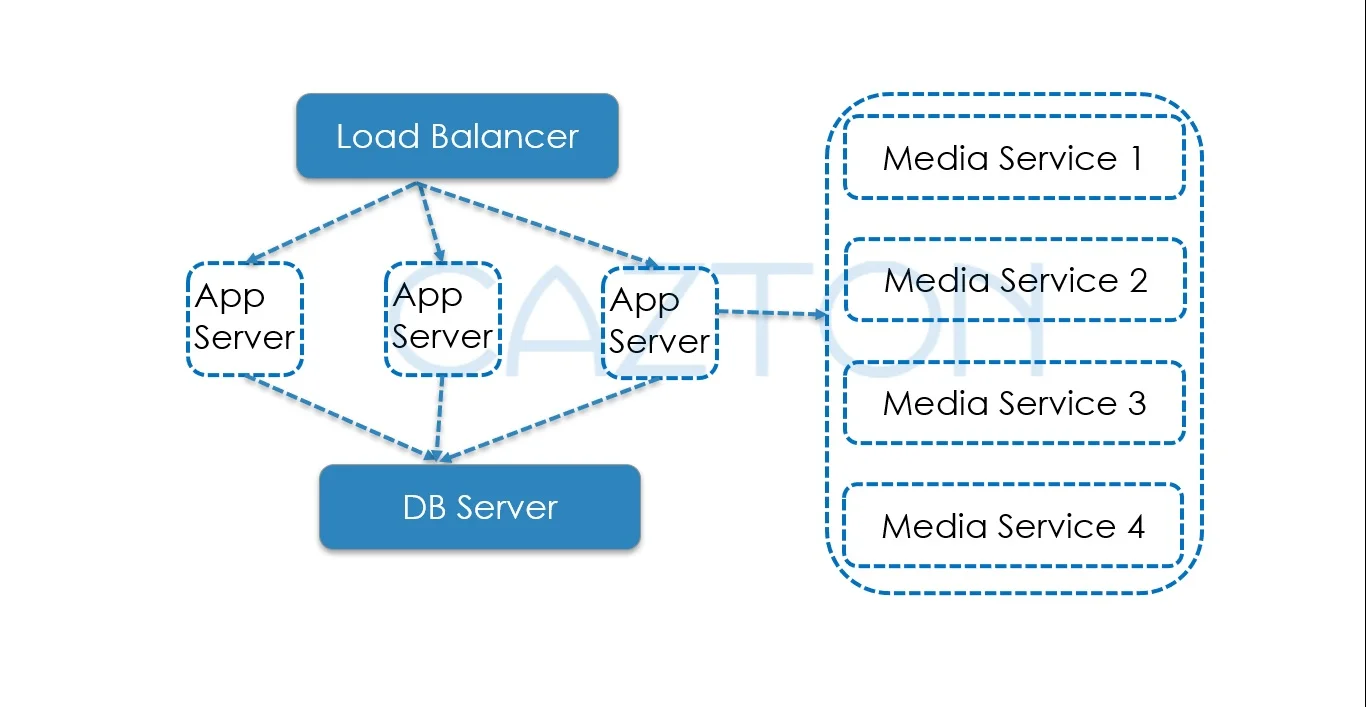
Scaling the Media service that has video, picture and thumbnail functionality.
However, when business needs evolve, such as the addition of thumbnails for video previews, we are required to modify and redeploy the entire media service. This happens even if the video and picture functionalities remain unchanged. Moreover, scaling thumbnails presents different challenges compared to videos. For instance, large numbers of thumbnails may exceed file system limits, unlike video scaling, which can rely on CDN-based delivery.
In scenarios where specific videos become highly popular, we may need to place them on faster storage or cache them closer to users. Yet with a monolithic setup, we must replicate the entire media service regardless of which part needs optimization. If the original service is built using an outdated or discontinued framework, transitioning to a more efficient technology requires rewriting the whole service, highlighting the inflexibility and operational risk of the monolithic model.
Enabling Independent Scaling and Deployment Through Microservices
Microservices architecture addresses these constraints by breaking down applications into independently deployable, modular services aligned with specific business capabilities.
Returning to our earlier example, the system would now comprise distinct Video and Photo services. Suppose the Video service is built using .NET and the Photo service in Java. Later, a Thumbnail service might be added using Node.js. Each of these services can scale independently based on its unique usage and performance demands.
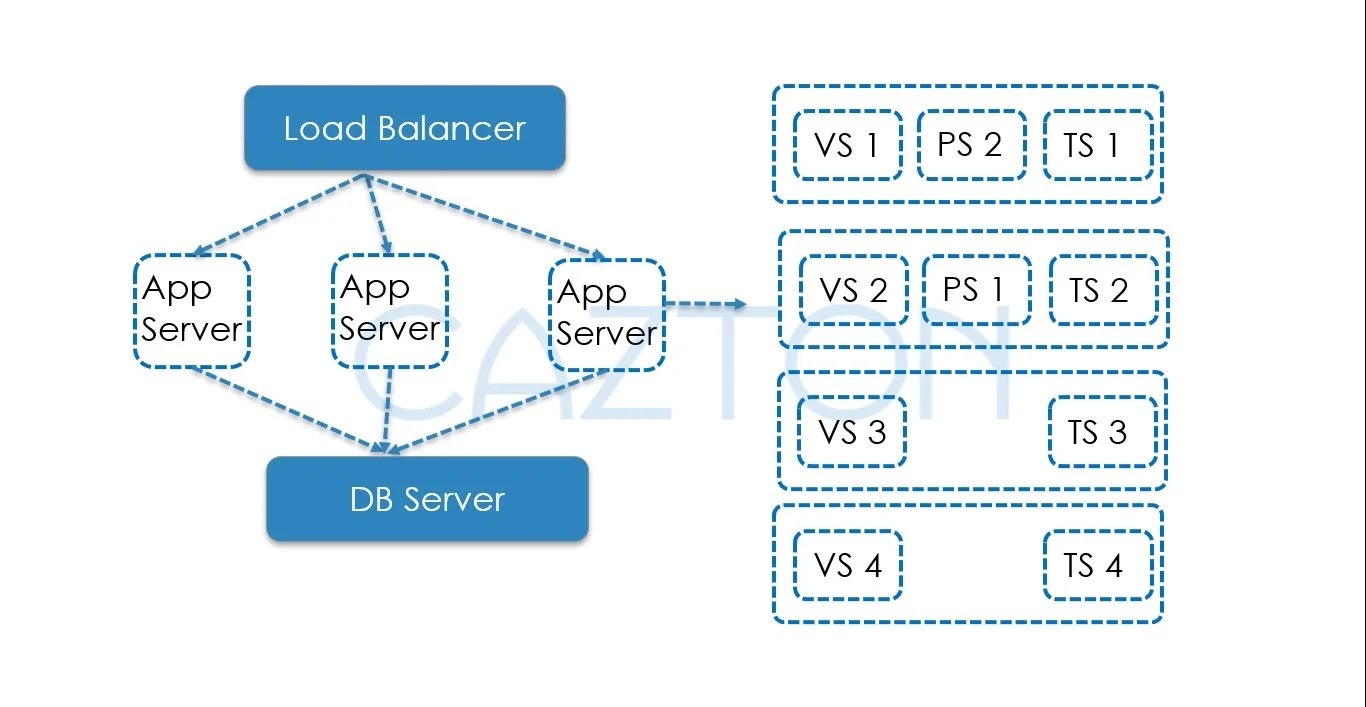
Scaling independent microservices for video, photo and thumbnail.
In the diagram, we see four instances of the Video and Thumbnail services (VS1-4 and TS1-4, respectively) and two instances of the Photo service (PS1-2). This architecture allows for targeted scalability and technological diversity.
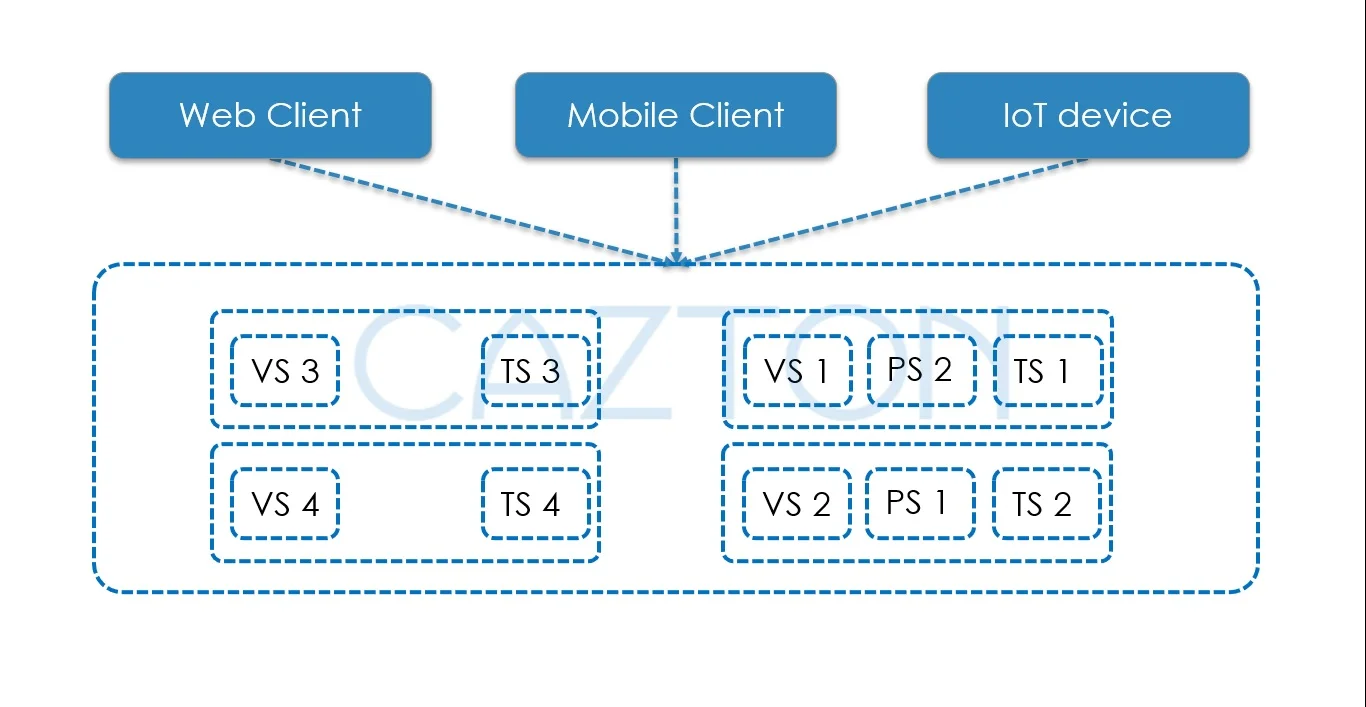
Independently scaled microservices being consumed by different types of clients.
By decoupling services, improvements such as caching videos near users can be implemented without affecting the Photo or Thumbnail services. This modularity enables multiple client types to consume services in a streamlined and efficient manner.
Services That Scale Independently
A key challenge in monolithic architectures is dependency and versioning conflicts. Suppose users now request audio playback and subtitle generation from video content. In a monolithic system, adding these features requires modifying the media service to integrate new components like a text parser and audio file generator. These shared packages must align on versioning, which may prevent independent updates, creating tight coupling between unrelated components.
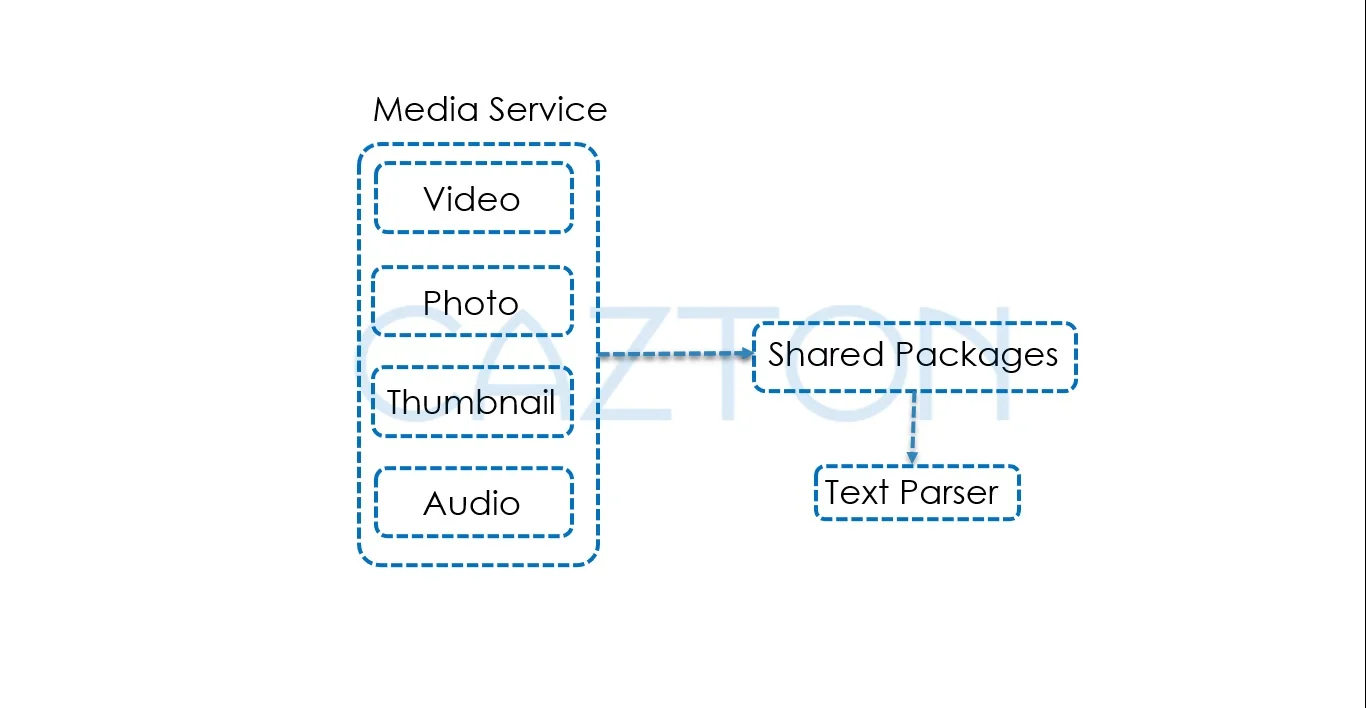
Media service using the same version of shared packages (including the text parser) for the video, photo, thumbnail and audio functionality.
In contrast, microservices allow each component to manage its own dependencies. The Video service could use Text Parser version 1, while the Audio service uses version 2. Changes to one will not disrupt the other. This autonomy supports continuous delivery, technology diversity, and scalability, while reducing dependency-related deployment risks.
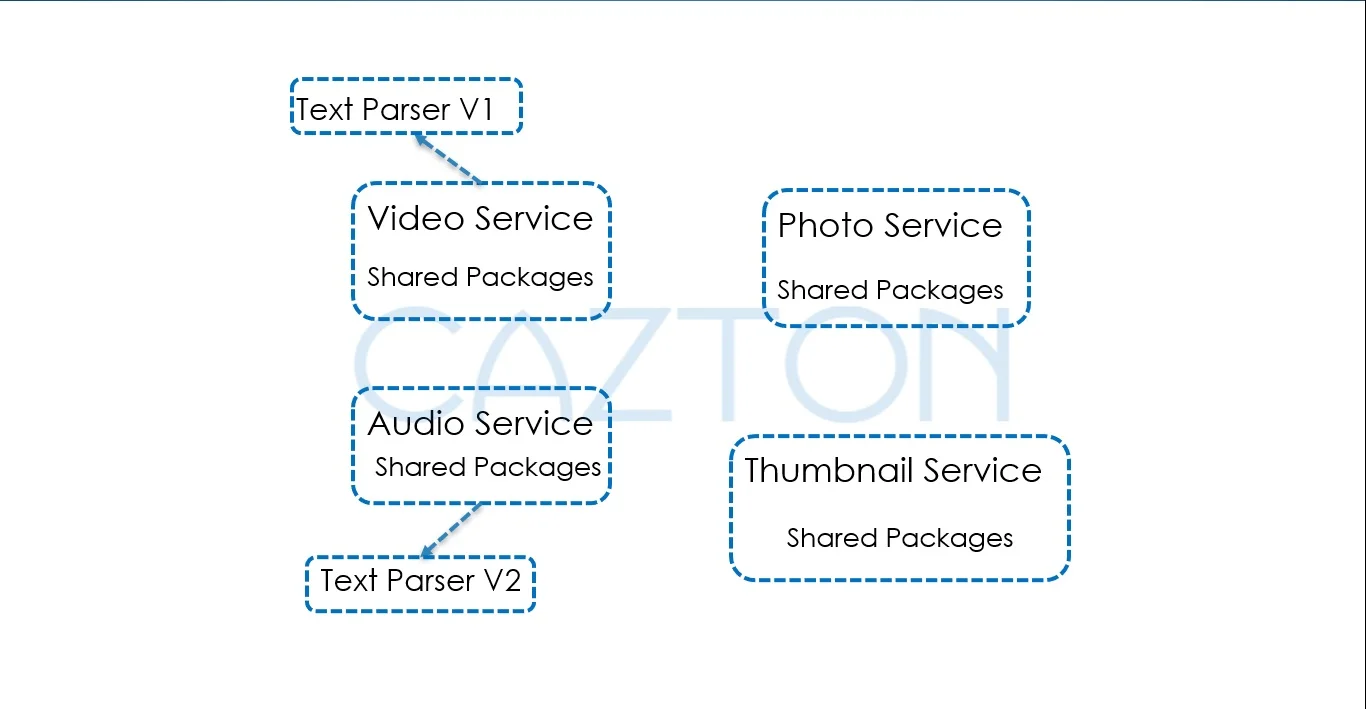
Microservices architecture showing use of different versions of the Text Parser in Audio and Video service.
Additionally, while HTTP is stateless, modern applications often require a mix of stateless and stateful services. Cloud platforms like Microsoft Azure support this through services such as Azure Service Fabric, which offers both stateless and stateful microservices. These services are modular by design, separating code, configuration, and data to support targeted scaling.
Stateless microservices benefit from queues and distributed storage to manage state externally. Stateful services, on the other hand, provide low latency and eliminate the need for caches and queues. It is generally advisable to start with stateless services and introduce state only when needed, ensuring long-term flexibility, scalability, and resilience as business needs evolve.
How to Rethink Architecture with Microservices
Unlike traditional monolithic applications where all functionality resides within a single codebase, microservices decompose complex applications into smaller, manageable components that can be built, deployed, and scaled independently. This architectural approach enables organizations to achieve greater agility, resilience, and alignment between technical capabilities and business objectives.
The core principles of microservices establish the foundation for successful implementation:
- Single responsibility: Each service is designed to handle one specific business function or capability, ensuring clear boundaries and reducing complexity. This principle promotes maintainability and allows teams to develop deep expertise in their respective domains while minimizing the risk of unintended side effects across the system.
- Independence: Services operate autonomously, enabling teams to develop, deploy, and scale them independently without coordinating with other service teams. This independence accelerates development cycles and allows organizations to respond quickly to changing business requirements while maintaining system stability.
- Decentralization: Teams maintain complete autonomy over their services, from initial design and technology selection to ongoing operation and maintenance. This decentralized approach empowers teams to make optimal decisions for their specific use cases while fostering innovation and ownership.
- Resilience: The architecture is designed so that failure in one service does not cascade to bring down the entire application ecosystem. This fault isolation ensures that critical business functions remain operational even when individual components experience issues, significantly improving overall system reliability.
- Evolutionary design: The architecture can adapt and evolve over time as business needs change, allowing organizations to modify individual services without restructuring the entire system. This flexibility enables continuous improvement and supports long-term strategic initiatives while preserving existing investments.
A comprehensive microservices architecture incorporates several key components that work together to create a robust, scalable system:
- Services: The individual microservices that implement specific business capabilities, each designed with clear interfaces and well-defined responsibilities. These services form the core building blocks of architecture and are optimized for their specific business domains and performance requirements.
- API gateway: Serves as the single entry-point for all client requests, handling cross-cutting concerns such as authentication, rate limiting, and request routing. The gateway simplifies client interactions while providing centralized control over security policies and system access patterns.
- Service discovery: Provides dynamic registration and discovery mechanisms that help services locate and communicate with each other efficiently. This component manages the complexity of distributed systems by maintaining accurate service registries and enabling automatic failover capabilities.
- Messaging system: Facilitates asynchronous communication between services, enabling loose coupling and improved system resilience through event-driven interactions. These systems handle complex communication patterns and ensure reliable message delivery even in the face of temporary service unavailability.
- Distributed data management: Each service manages its own data persistence layer, often utilizing different database technologies optimized for specific use cases. This approach eliminates shared database bottlenecks while allowing teams to select the most appropriate data storage solutions for their requirements.
- Monitoring and observability tools: Provide comprehensive visibility into system health, performance metrics, and inter-service dependencies across the distributed architecture. These tools enable proactive issue detection and resolution while supporting data-driven optimization decisions.
In practice, microservices create substantial value by enabling organizations to align their technical architecture with business domains and team structures. Our approach to microservices implementation focuses on identifying optimal service boundaries based on your unique business domains and operational capabilities. We help you determine which components of your existing application would benefit most from microservices architecture and design a comprehensive roadmap that delivers incremental value while effectively managing complexity.
The Strategic Drivers Behind Microservices Adoption
The enterprise application landscape continues to evolve rapidly, and microservices have emerged as a key architectural approach for organizations pursuing agility, scalability, and innovation. For executives, this shift represents both an opportunity and a challenge. While the potential benefits are significant, the path to adoption can be complex and demanding.
Several key business trends are accelerating the move toward microservices:
- Digital transformation imperatives: Customer expectations are evolving faster than ever. To stay relevant, enterprises must be able to introduce new digital capabilities quickly and iterate on them continuously.
- Cloud migration initiatives: Cloud-native applications are best suited for distributed, resilient architectures. Microservices align naturally with cloud environments, enabling better resource utilization, fault isolation, and elastic scaling.
- Talent attraction and retention: Skilled developers increasingly seek opportunities to work with modern tools and architectures. Organizations that embrace microservices are better positioned to attract top engineering talent and foster a culture of innovation.
- Competitive pressure: Markets are moving fast. Businesses that can deploy updates and roll out new features rapidly gain a significant edge in customer responsiveness and product evolution.
Despite these drivers, many enterprises remain cautious. Concerns around operational complexity, system observability, governance, and cultural readiness often slow down or stall modernization initiatives. These are valid considerations. The real challenge is not the architecture itself, but the execution. Successful microservices adoption demands thoughtful planning, cross-functional collaboration, and a strong alignment between technology and business goals.
Our experience shows that lasting success with microservices starts with strategy, not tooling. We begin by aligning services with your business domains and capabilities, ensuring that architecture reflects the way your organization delivers value. This approach enables you to scale technology alongside your business, simplify operations over time, and realize measurable outcomes. Whether you're just beginning your modernization journey or looking to accelerate existing efforts, we help close the gap between ambition and execution.
Case Studies
Global Scale DevOps Transformation
- Problem: A multinational corporation struggled with inconsistent development and deployment practices across regional teams, resulting in lengthy release cycles, frequent production issues, and inability to maintain consistent quality standards. Each region operated with different toolchains, deployment procedures, and monitoring systems, creating operational silos that hindered collaboration and slowed innovation. The organization needed to unify their development practices while respecting regional autonomy and compliance requirements.
- Solution: We established a standardized container orchestration platform that provided consistent CI/CD pipelines, automated testing frameworks, and unified monitoring across all regions. The platform included region-specific compliance controls, localized deployment strategies, and standardized development workflows that enabled teams to collaborate effectively while maintaining operational independence and meeting local regulatory requirements.
- Business impact: The organization reduced deployment time from weeks to hours, decreased production incidents by 75%, and enabled seamless collaboration between global teams. They achieved consistent quality standards across all regions while maintaining compliance with local regulations, ultimately accelerating time-to-market for new features and improving customer satisfaction scores.
- Tech stack: Kubernetes, Docker, Azure, Azure DevOps, GitHub Actions, Jenkins, Prometheus, Grafana, Sonarqube, Microsoft Fabric, Azure Cosmos DB, Redis, Azure AI, Copilot, Kafka, .NET, Angular, Azure AI Search.
Regulatory Compliance Automation
- Problem: A financial services organization faced mounting pressure to meet increasingly complex regulatory requirements across multiple jurisdictions while maintaining operational efficiency. Manual compliance processes were error-prone, time-consuming, and created bottlenecks that delayed product launches and feature releases. The organization needed to automate compliance verification without compromising security or operational flexibility.
- Solution: We designed a compliance-first container platform that embedded regulatory controls directly into the deployment pipeline, automatically enforcing security policies, data residency requirements, and audit trails. The platform included automated vulnerability scanning, policy validation, and compliance reporting that ensured every deployment met regulatory standards while maintaining the agility needed for competitive advantage.
- Business impact: The organization reduced compliance verification time from months to days, eliminated manual audit processes, and achieved 100% compliance success rates across all regulatory frameworks. They gained the ability to launch new products faster while maintaining rigorous security standards, ultimately improving market responsiveness and reducing regulatory risk.
- Tech stack: Kubernetes, Docker, Terraform, Databricks, Elasticsearch, Kibana, ArgoCD, Istio, Java, React.js, Spark, AWS, Amazon Kendra.
Disaster Recovery and Business Continuity
- Problem: A healthcare organization required zero-downtime operations and rapid disaster recovery capabilities to maintain critical patient care systems. Their existing infrastructure lacked automated failover mechanisms and required manual intervention during outages, creating unacceptable risks to patient safety and regulatory compliance. The organization needed a resilient platform that could automatically handle failures and maintain service availability.
- Solution: We implemented a multi-region container platform with automated failover, continuous data replication, and self-healing capabilities that ensured uninterrupted service delivery. The platform included automated backup strategies, cross-region redundancy, and intelligent traffic routing that maintained service availability even during major infrastructure failures while meeting healthcare industry compliance requirements.
- Business impact: The organization achieved 99.99% uptime, reduced recovery time from hours to minutes, and eliminated single points of failure across their critical systems. They gained confidence in their disaster recovery capabilities while reducing operational overhead and ensuring continuous patient care delivery during any infrastructure disruption.
- Tech stack: Kubernetes, Docker, Velero, Longhorn, Thanos, Consul, Envoy, Node.js, Blazor, External-DNS, Vue.js, Databricks, Cluster-API, Crossplane, Kustomize, Google Cloud, OpenAI.
Resource Optimization and Cost Management
- Problem: A rapidly growing e-commerce company experienced unpredictable traffic patterns and seasonal demand fluctuations that made capacity planning extremely difficult. Their infrastructure was over-provisioned for peak loads, resulting in significant waste during low-traffic periods, while under-provisioning during unexpected spikes led to poor customer experiences and lost revenue. The organization needed intelligent resource management that could adapt to changing demand patterns.
- Solution: We created an intelligent container platform with predictive scaling, automated resource optimization, and cost-aware scheduling that dynamically adjusted capacity based on real-time demand and historical patterns. The platform included multi-tier scaling strategies, spot instance integration, and workload prioritization that maximized resource utilization while maintaining performance guarantees for critical business functions.
- Business impact: The organization reduced infrastructure costs by 40% while improving application performance and customer satisfaction. They gained the ability to handle traffic spikes without manual intervention while optimizing resource usage during low-demand periods, ultimately improving both operational efficiency and customer experience.
- Tech stack: Kubernetes, Docker, HPA, ASP.NET Core, Electron.js, VPA, Ionic, Prometheus, Microsoft Fabric, Grafana, Azure, Karpenter, Azure AI, Helm, Azure OpenAI.
How Cazton Can Help You With Microservices
At Cazton, we bring together deep microservices technical expertise and business transformation experience to deliver implementations that drive measurable outcomes. Our approach goes beyond technology to address the organizational, process, and people aspects of successful microservices adoption.
We understand that microservices implementation isn't just about breaking down monoliths; it's about transforming how your business delivers software. Our team works closely with your stakeholders to understand your unique challenges, constraints, and opportunities. We then develop tailored solutions that leverage microservices architecture to address your specific business needs.
Our microservices services include:
- Microservices strategy and assessment: Our experts collaborate with your leadership and technical teams to create actionable roadmaps that align microservices adoption with your business goals.
- Domain-driven design workshops: We guide teams through hands-on sessions to define service boundaries based on real business domains, ensuring the architecture reflects your organizational structure.
- Microservices architecture design: We design scalable and resilient systems tailored to your performance needs, cloud strategy, and operational realities.
- Monolith to microservices migration: Our approach focuses on incremental decomposition of legacy systems, reducing risk while accelerating modernization.
- DevOps implementation: We build and optimize CI/CD pipelines and automation frameworks that support efficient, reliable microservices delivery.
- Microservices security design: Our team implements robust, end-to-end security controls across services, covering identity, data protection, and secure communications.
- Data architecture for microservices: We develop distributed data strategies that ensure consistency, availability, and performance across service boundaries.
- Microservices governance framework: Our consultants establish standards for service ownership, deployment, and versioning to ensure long-term maintainability and scale.
- Advanced pattern implementation: We help you apply proven architectural patterns such as event sourcing and CQRS to meet complex data and domain challenges.
- Team enablement and training: We accelerate internal capability development through hands-on coaching, structured knowledge transfer, and embedded team collaboration.
Our microservices professionals bring experience from diverse industries and complex implementation scenarios. We combine this expertise with a collaborative approach that ensures knowledge transfer and capability building throughout the engagement.
Partner with us to accelerate your microservices journey while minimizing risk and maximizing business value. Contact us today to discuss how we can help you achieve your application modernization goals.
Cazton is composed of technical professionals with expertise gained all over the world and in all fields of the tech industry and we put this expertise to work for you. We serve all industries, including banking, finance, legal services, life sciences & healthcare, technology, media, and the public sector. Check out some of our services:
- Artificial Intelligence
- Big Data
- Web Development
- Mobile Development
- Desktop Development
- API Development
- Database Development
- Cloud
- DevOps
- Enterprise Search
- Blockchain
- Enterprise Architecture
Cazton has expanded into a global company, servicing clients not only across the United States, but in Oslo, Norway; Stockholm, Sweden; London, England; Berlin, Germany; Frankfurt, Germany; Paris, France; Amsterdam, Netherlands; Brussels, Belgium; Rome, Italy; Sydney, Melbourne, Australia; Quebec City, Toronto Vancouver, Montreal, Ottawa, Calgary, Edmonton, Victoria, and Winnipeg as well. In the United States, we provide our consulting and training services across various cities like Austin, Dallas, Houston, New York, New Jersey, Irvine, Los Angeles, Denver, Boulder, Charlotte, Atlanta, Orlando, Miami, San Antonio, San Diego, San Francisco, San Jose, Stamford and others. Contact us today to learn more about what our experts can do for you.


